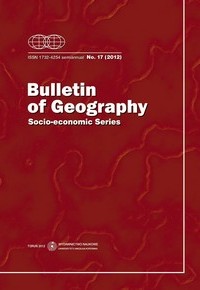Opportunities and restrictions for the local-endogenous development in metropolitan areas of high industrial concentration: the case of Thriasio Pedio in Attica
DOI:
https://doi.org/10.1515/v10089-012-0003-7Keywords
Greece, Thriasio Pedio, Athens Metropolitan Area, local-endogenous development, industrial districts, local productive systems, innovative and creative milieuAbstract
This paper investigates the development pattern of the urban area of Thriasio Pedio in the metropolitan region of Attica, which is characterised by a high concentration of industrial activities. The local-endogenous development model is discussed in the theoretical review of the paper, in the sense of the local socio-economic system's capacity to transform, react to external challenges, promote awareness and import specific forms of social regulation at the local level. On this ground, the main question of the paper concerns the nature of the area's development and more specifically, whether or not this is defined by endogenous factors (i.e. the operation of locally embedded production systems) along with predetermined exogenous factors (i.e. the allocation of central/metropolitan activities in Thriasio Pedio). The study is supported by the results of a sampling research in representative economic units of the Thriasio Pedio area. The analysis helped us to see whether the various applications of the local-endogenous development pattern, as defined in the paper, are incorporated into the overall productive system of the area. The prerequisites for the reinforcement of the local endogenous capacity were also identified in this analysis.References
Amin, A. and Thrift, N. 1995: Globalisation, institutional ‘thichness’ and the local economy. In: Healey, P., Cameron, S., Davoudi, S., Graham, S. and Madani-Pour, A. editors, Managing cities: the new urban context, Chichester: Willey and Sons, pp. 92-108.
Aydalot, P. 1986: Les milieux innovateurs en Europe, Paris: Gremi.
Barquero, A. 1991: Local development, A strategy for job creation, Athens: Papazisis.
Becattini, G. 1990: The Marshallian industrial district as a socio-economic notion. In: Pyke, F., Becattini, G. and Sengenberger, W. editors, Industrial districts and inter-firm cooperation in Italy, Geneva: International Institute for Labour Studies, pp. 37-51.
Benko, G., Dunford, M. and Heurley, J. 1997: Districts industriels: vingt ans de recherches. In: Espaces et Societes, Vol. 88/89, pp. 305-327.
Bennett, R. and Krebs, G. 1991: Local economic development, London: Belhaven.
Broecker, J., Dohse, D. and Ruediger, S. (editing-introduction) 2003: Innovation clusters and interregional competition, Berlin: Springer.
Brusco, S. 1990: The idea of industrial district: its genesis. In: Pyke, F., Becattini, G., and Sengenberger, W. editors, Industrial districts and inter-firm cooperation in Italy, Geneva: International Institute for Labour Studies, pp. 10-19.
Christofakis, M. 2010: Strategic options for tourism impacts on local sustainability: a conceptual approach. In: Local Economy, Vol. 25 (7), pp. 589-601.
http://dx.doi.org/10.1080/02690942.2010.532357
Coffey, S. and Polese, M. 1985: Local development, conceptual bases and policy implications. In: Regional Studies, Vol. 19 (2), pp. 85-93.
http://dx.doi.org/10.1080/09595238500185101
Cooke, P. and Morgan, K. 1998: The associational economy: firms, regions and innovation, Oxford: Oxford University Press.
Developmental Union of Thriasio Pedio, 2003: Enterprises Census, Eleusina: Developmental Union of Thriasio Pedio.
Gouttebel, J. 2001: Strategies de developpement territorial, Paris: Economica.
Grosjean, N. and Crevoisier, O. 2003: Autonomie differenciee des systemes de production territoriaux. In: Revue d'Economie Regionale et Urbaine, ADICUEER, Vol. 2, pp. 291-315.
Harrison, B. and Storper, M. 1991: Flexibility hierarchy and regional development: the changing structure of industrial production systems and their forms of governance in the 1990s. In: Research Policy, Vol. 20 (5), pp. 343-373.
Isserman, A. 1977: The location quotient approach to estimating regional economic impacts. In: Journal of the American Planning Association, Vol. 43 (1), pp. 33-41.
http://dx.doi.org/10.1080/01944367708977758
Maier, J. and Obermaier, F. 2001: Creative milieus and regional networks: local strategies and implementation in case studies in Bavaria. In: Schatzland, L. and Revilla, D. editors, Technological change and regional development in Europe, Berlin: Physica-Verlag, pp. 211-232.
Maillat, D. 1998: Innovative milieux and new generations of regional policies. In: Entrepreneurship & Regional Development, Vol. 10 (1), pp. 1-16.
http://dx.doi.org/10.1080/08985629800000001
Malecki, E. 1997: Entrepreneurs, networks and economic development: A review of recent research. Advances in entrepreneurship. In: Firm Emergence and Growth, Vol. 3, pp. 57-118.
Markusen, A. 1996: Sticky places in slippery space: a typology of industrial districts. In: Economic Geography, Vol. 72 (3), pp. 293-313.
http://dx.doi.org/10.2307/144402
Mayer, W. and Pleeter, S. 1975: A theoretical justification for the use of location quotients. In: Regional Science and Urban Econonomics, Vol. 5 (3), pp. 343-355.
http://dx.doi.org/10.1016/0166-0462(75)90030-7
NSSG (National Statistical Service of Greece), 2010: Population Censuses 1991 and 2001, Athens: NSSG.
Palazuelos, M. 2005: Clusters: myth or realistic ambition for policy-makers? In: Local Economy, Vol. 20 (2), pp. 131-140.
http://dx.doi.org/10.1080/13575270500053225
Paniccia, I. 2002: Industrial districts, evolution and competitiveness in Italian firms, London: Edward-Elgar.
Papadaskalopoulos, A. 2008: Patterns and policies of regional development, Athens: Dionikos, 2nd edition.
Pratt, A. 2010: Creative cities: tensions within and between social, cultural and economic development. A critical reading of the UK experience. In: City, Culture and Society, Vol. 1 (1), pp. 13-20.
http://dx.doi.org/10.1016/j.ccs.2010.04.001
RDI (Regional Development Institute) and FEIR (Foundation of Economic and Industrial Researches), 2008: Action plan for the spatial and sectoral development of Thriasio Pedio and Western Attica, Athens: Organisation for the Regulatory Planning and Environmental Protection of Athens-Prefecture of Western Attica.
Scott, A. and Storper, M. 1989: The geographical foundations and social regulation of flexible production complexes. In: Wolch, J. and Dean, M. editors, The power of geography: How territory shapes social life, Boston: Unwin Hyman, pp. 21-40.
Theveniaut-Muller, M. 1999: Le developpement local, une reponse politique a la mondialisation, Paris: Desclee de Brouwer.
Tiebout, C. 1956: Exports and regional economic growth. In: Journal of Political Economy, Vol. 64 (2), pp. 160-169.
Downloads
Published
How to Cite
Issue
Section
License
Title, logo and layout of journal Bulletin of Geography. Socio-economic Series are reserved trademarks of Bulletin of Geography. Socio-economic Series.Stats
Number of views and downloads: 505
Number of citations: 0



